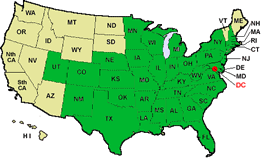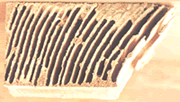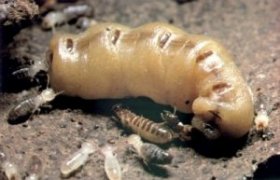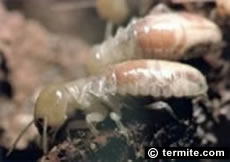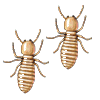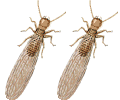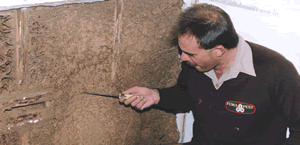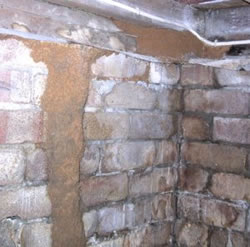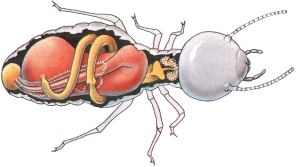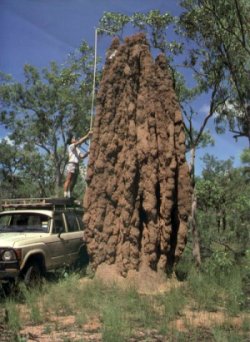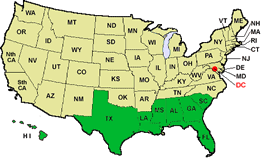| About Termites |
| Termite Control |
| Exterra |
| Sentricon |
| Pest Control |
| Spider Identification |
| Consumer Advice |
| Links / Resources |
| Home |
| Destructive Termites in Alabama |
| Identification of the main destructive species |
| It is critical to identify the species of destructive termites to formulate
an appropriate control program. The main species of destructive
termites in Alabama are: CONTENTS: learn about destructive species of termites - tips on identification of the timber damage - find out when they swarm in your local area and how to identify the swarmers, workers and soldiers - learn about their fascinating biology, life-cycle and behavioural aspects - and receive professional tips on how best to protect your home from the world's best timber recycler .... subterranean termites. |
Areas of high risk in Alabama include Alabaster - Albertville - Anniston - Athens - Auburn - Bessemer - Birmingham - Daphne - Decatur - Dothan - Enterprise - Florence - Gadsden - Homewood - Hoover - Huntsville - Madison - Mobile - Montgomery - Mountain Brook - Northport - Opelika - Oxford - Pelham - Phenix City - Prattville - Prichard - Trussville - Tuscaloosa - Vestavia Hills . |
As a result, infested timbers are often left as a thin external shell, with layered "honey-comb" hollow sections (as illustrated) packed with moist soil. Eastern subterranean termites thrive in a moist dark environment. Moisture and humidity control are essential for their survival. |
| The Eastern subterranean termite is a serious economic timber pest causing millions of dollars of damage throughout Alabama. It is estimated that more than 1 in 5 homes in the urban areas of most Alabama cities have been or will be attacked at sometime by these voracious little insects. |
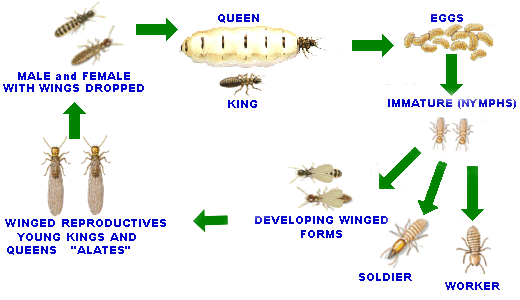
|
|
|
As noted above, termites constantly groom and feed each other. A valuable technique for the termite controller is to instal and monitor a termite baiting system next to any live activity found in and around the premises where termite foraging is most likely to occur. Subsequent inspections (preferably monthly) may reveal dead or sick worker termites, they change colour to a mottle look, and spread of the termite bait to other termites leading to elimination of the colony. The termite baits are designed to be non-repellant to the termites and has a unique delayed effect. Time enough to be passed onto the other termites in the colony including the queen, with a sufficient dosage leading to the elimination of the entire colony. This process is explained in detail in the Termite Control section of this website. |
Eastern subterranean termites have acute survival instincts. If they
are shaken up or disturbed, the termites often will abandon the associated
area and move on to secretly
cause damage in other areas in the building. If you find eastern
subterranean termites in or around your property, it is essential that you
do NOT disturb them and promptly arrange for a professional inspection and
application of a termite bait to the live termites, if present in abundance.
|
| Formosan subterranean termites |
Economic Significance: Formosan termites
are the most aggressive and destructive timber pests in the United States.
It is an imported species, native to China.
It can develop huge nests containing millions of termites aggressively and relentlessly seeking and devouring structural timbers, utility poles and other timber structures, including ships and barges. Infestation can occur to living trees, such as oak, cypress, pine and maple. They often cause power failures by chewing through electrical cabling. A termite to be feared - it is known to cause major structural timber damage to homes and buildings within a few months.
Formosan termites are a serious timber pest in Hawaii and coastal regions of Texas, Louisiana, Alabama, Florida, Tennessee, Georgia, South Carolina and southern California, as well as, inland towns and cities. The Formosan termite is rarely found North of 35° N latitude. They have been reported from the following states: Alabama, California, Florida, Georgia, Hawaii, Louisiana, Mississippi, North Carolina, South Carolina, Tennessee, and Texas. Their distribution will probably continue to be restricted to southern areas because their eggs will not hatch below about 20° C (68° F). Identification of Swarmers and Soldiers: Formosan termites swarm in huge numbers in late spring or summer; usually following a warm rainy day. They prefer to swarm in times of high humidity in the evening hours from dusk to midnight. The swarmers are attracted to lights and are about 1/25'', including wings. Their body color is pale yellowish brown. A fontanelle (frontal gland pore) is present. The swarmers have four wings of equal size with dark hard veins in the front portion of the front wing. The wings are a translucent, slightly milky color and covered with tiny hairs. The armoured head of the soldier is rounded tapering toward the front. A fontanelle (frontal gland pore) is present on the soldier's forehead. They have large mandibles relative to their body, which is flat and narrower than the head. When disturbed the Formosan soldier termite may emit a white sticky latex substance from it's fontanelle - a defensive measure to ensnare their enemies, primarily ants. Identification of Timber Damage: Formosan termites eat mainly the springwood of susceptible timbers, most often leaving the summer wood sections. Timbers infested by Formosan termites usually have layered sections packed with moist soil in high activity areas. Biology and Habits: Formosan termites are subterranean termites that typically live in the ground and a large mature nest will periodically emit swarmers in large numbers over a wide area to find a mate from another colony nest to start up a new colony. A suitable location for nesting should provide a constant moisture source and a readily available timber food source close by. Several years are required before the termite colony reaches the typically mature size, which may contain millions of termites foraging for timber food sources within a 400 feet radius, actively feeding on trees and free-standing poles as well as buildings and other timber structures. The colony nests of Formosan termites are usually located in the ground below the frost line, but above the water table. They typically construct mud galleries or "shelter tubes" across hard objects in order to gain access to timber food sources. Formosan termites constantly search for new food sources. They are known to enter buildings through cracks in concrete flooring or to travel under parquetry or tile flooring through gaps of less than 1/16" wide. The space between the foundation and the first mortar joint is often enough space for termites to enter a home. Formosan termites can establish secondary colonies in very moist wood of upper stories of buildings (even several stories above ground) and do not need soil contact if there is a nearly constant moisture source. Where moisture regularly collects inside the wall or other cavities of a building, say from faulty plumbing or broken roof tiles, the Formosan termite can develop a subsidiary colony nest, which may not require contact with the ground to ensure its survival. This is particularly prevalent in areas of high humidity where wood moisture is above average. Due to its size and aggressive foraging behaviour a colony of Formosan termites does more damage than single colonies of other U.S. subterranean species, and can cause significant structural damage to a home within 6 months. |
| Learn about professional Termite Control ...Click on Termite Control |










| |
| Published by Fumapest Group © copyright 1995 - |

